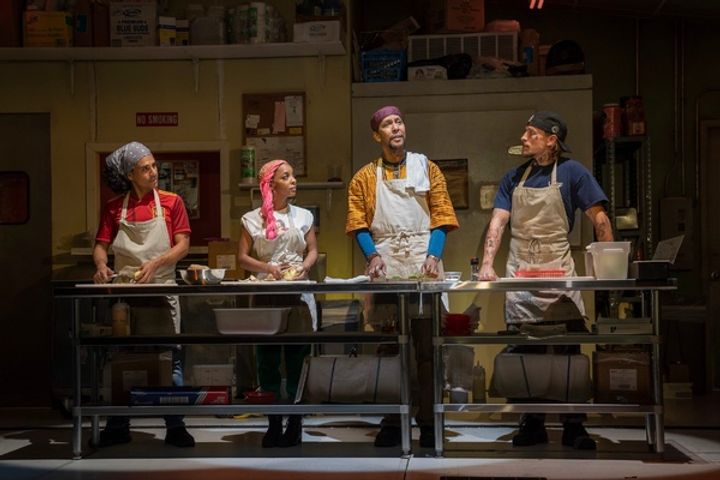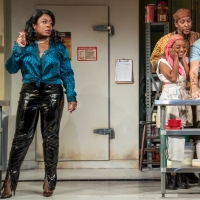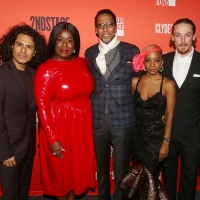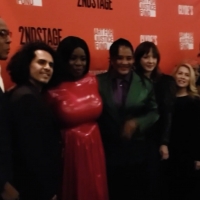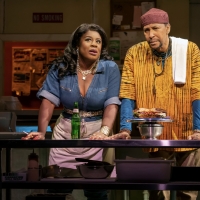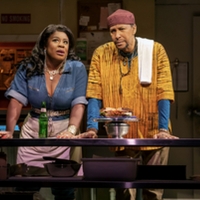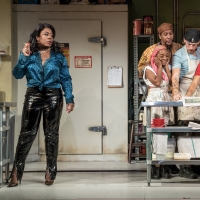Clyde's
Closing: January 16, 2022Clyde's - 2021 Broadway History , Info & More
Hayes Theatre (Broadway)
240 West 44th St. New York, NY
In CLYDE’S, a stirring new play from two-time Pulitzer Prize winner Lynn Nottage and her frequent collaborator, director Kate Whoriskey (Ruined, Sweat), a truck stop sandwich shop offers its formerly incarcerated kitchen staff a shot at redemption. Even as the shop’s callous owner tries to keep them under her thumb, the staff members are given purpose and permission to dream by their shared quest to create the perfect sandwich. You’ll want a seat at the table for this funny, moving, and urgent play. It’s an example of Nottage’s “genius for bringing politically charged themes to life by embodying them in ordinary characters living ordinary lives” (The Wall Street Journal).
The full creative team for Clyde’s includes scenic design by Takeshi Kata, costume design by Jennifer Moeller, lighting design by Christopher Akerlind, sound design by Justin Ellington, original compositions by Justin Hicks and casting by The Telsey Office.
Clyde’s is supported by the Art for Justice Fund, a sponsored project of Rockefeller Philanthropy Advisors and by Terry and Bob Lindsay, with additional support provided by American Express.
Clyde's - 2021 - Broadway Cast
FEATURED REVIEWS FOR Clyde's
Clyde’s Review: Uzo Aduba in Lynn Nottage’s play of holy sandwich makers
8 / 10
In 'Clyde's,' a savory comedy written by Lynn Nottage, better known for her bitter tragedies, Uzo Aduba portrays Clyde, the sexy but heartless owner of a truck stop where all four of her employees are ex inmates, as is she. The chief joke of the play, which is running at Second Stage's Helen Hayes Theater through January 16, is how seriously the employees take the art and craft of sandwich making, especially Ron Cephas Jones as Montrellous, whom the others worship for his culinary gifts. The chief delight of this production, directed by frequent Nottage collaborator Kate Whoriskey, is the art and craft of the theater making, by an extraordinarily talented cast, and also by the designers, who get whimsical and weird (in a good way.)
‘Clyde’s’ Review: Uzo Aduba Stars in Lynn Nottage’s New Broadway Comedy
8 / 10
Nottage, a Pulitzer winner for the more weighty topical dramas 'Ruined' and 'Sweat,' maintains her interest in illuminating the lives of working class people, but shifts strategies here into broad comedy. The setup has a sitcom quality that's paradoxically inviting, not dissimilar to 'Orange Is the New Black,' for which Aduba won two Emmys; it's easy to imagine stopping by Clyde's every week, with a steady swinging door of short-order cooks working toward rehabilitation. The comedy is situational in both structure and execution, with personalities, incidents and drool-worthy sandwich descriptions making up a bulk of its substance.
Category
Clyde's History
Other Productions of Clyde's
| 2021 | Broadway |
Broadway |
Clyde's - 2021 Broadway Awards and Nominations
| Year | Ceremony | Category | Nominee |
|---|---|---|---|
| 2022 | Drama Desk Awards | Outstanding Costume Design for a Play | Jennifer Moeller |
| 2022 | Drama Desk Awards | Outstanding Featured Actor in a Play | Ron Cephas Jones |
| 2022 | Drama Desk Awards | Outstanding Lighting Design for a Play | Christopher Akerlind |
| 2022 | Drama Desk Awards | Outstanding Scenic Design for a Play | Takeshi Kata |
| 2022 | Drama League Awards | Distinguished Performance Awards | Uzo Aduba |
| 2022 | Drama League Awards | Distinguished Performance Awards | Ron Cephas Jones |
| 2022 | Drama League Awards | Outstanding Direction of a Play | Kate Whoriskey |
| 2022 | Drama League Awards | Outstanding Production of a Play | Clyde's |
| 2022 | Outer Critics Circle Awards | Outstanding Featured Actress in a Play | Uzo Aduba |
| 2022 | Outer Critics Circle Awards | Outstanding New Broadway Play | Clyde's |
| 2022 | Theatre World Awards | Theatre World Awards | Kara Young |
| 2022 | Tony Awards | Best Costume Design of a Play | Jennifer Moeller |
| 2022 | Tony Awards | Best Performance by an Actor in a Featured Role in a Play | Ron Cephas Jones |
| 2022 | Tony Awards | Best Performance by an Actress in a Featured Role in a Play | Uzo Aduba |
| 2022 | Tony Awards | Best Performance by an Actress in a Featured Role in a Play | Kara Young |
| 2022 | Tony Awards | Best Play | Clyde's |
Videos





